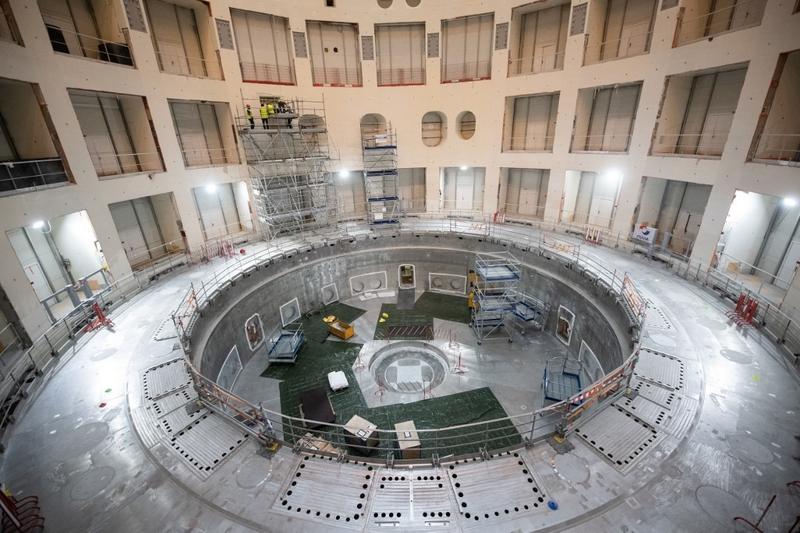 Technicians work on the bioshield inside the Tokamak Building with the base of the cryostat at its base during the launch of the assembly stage of nuclear fusion machine "Tokamak" of the International Thermonuclear Experimental Reactor (ITER) in Saint-Paul-les-Durance, southeastern France, on July 28, 2020. (CLEMENT MAHOUDEAU / AFP)
Technicians work on the bioshield inside the Tokamak Building with the base of the cryostat at its base during the launch of the assembly stage of nuclear fusion machine "Tokamak" of the International Thermonuclear Experimental Reactor (ITER) in Saint-Paul-les-Durance, southeastern France, on July 28, 2020. (CLEMENT MAHOUDEAU / AFP)
Construction of the world's largest nuclear fusion project has begun in Provence, in southern France, with the goal of demonstrating that unlimited amounts of clean power can be produced on a commercially viable scale.
Constructing the machine pieceby piece will be like assembling a three dimensional puzzle on an intricate timeline (and) with the precision of a Swiss watch.
Bernard Bigot, ITER’s director general
The project, which has a budget of 20 billion euros (US$23.5 billion) and employs 10,000 people, is called ITER. Half the funding will come from a united European effort, with the rest of the cost being shared equally by the United Kingdom, China, India, Japan, South Korea, Russia and the United States.
The project aims to replicate the reactions that take place inside the core of the sun and requires a temperature 10 times as hot as its core. Fusion reactors give off low levels of carbon dioxide, cannot melt down, and produce much less radioactive waste than other types of nuclear reactor.
ALSO READ: France to make wearing masks in public spaces mandatory
Assembly of the giant reactor, which will weigh almost 23,000 metric tons, be 60 meters high and known as a tokamak, is expected to last five years, and it will effectively operate as a star on Earth.
ITER was first suggested in 1985, and for decades, scientists have searched for a way to overcome such a technical challenge, but hopes are high that this international pooling of ideas and technology could take things further than anyone before. China's technical input has been supplied by the China National Nuclear Corporation.
The practical challenges alone of assembling such a piece of hardware are huge, with 200 kilometers of cabling being needed to connect almost 3,000 metric tons of magnets, kept at temperatures of minus 269 C in the world's biggest cryogenic plant.
Speaking at the launch, French President Emmanuel Macron called it "a project for the future of humanity".
President Xi Jinping sent a message of congratulations, commenting that science knows no borders, and international scientific and technological cooperation is of great significance to coping with global challenges facing mankind, according to CGTN.
A decade of involvement with Iter, he continued, showed that open communication is key to exploring scientific frontiers, and in the current international climate more than ever before, mankind needs to work hand in hand to overcome the difficulties.
South Korean President Moon Jae-in said his country remained committed to the project, which he said promised to generate an "energy source of dreams".
Bernard Bigot, ITER's director general, said bringing about a situation where people could rely exclusively on clean energy would be "a miracle for our planet" but he also warned of the size of the task that lay ahead.
READ MORE: France's Macron picks new PM to reinvent presidency
"Constructing the machine piece-by-piece will be like assembling a three-dimensional puzzle on an intricate timeline (and) with the precision of a Swiss watch," he said.


